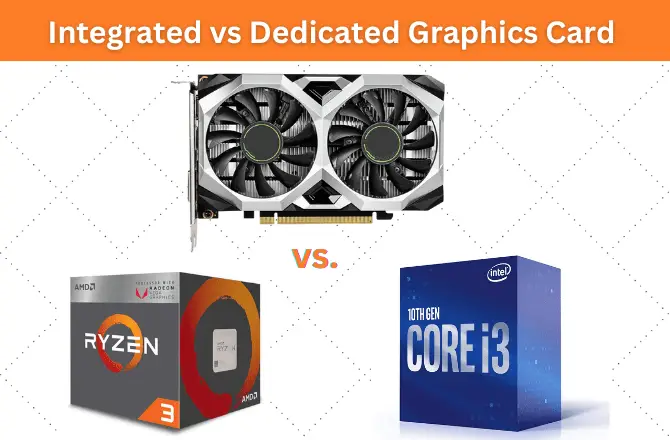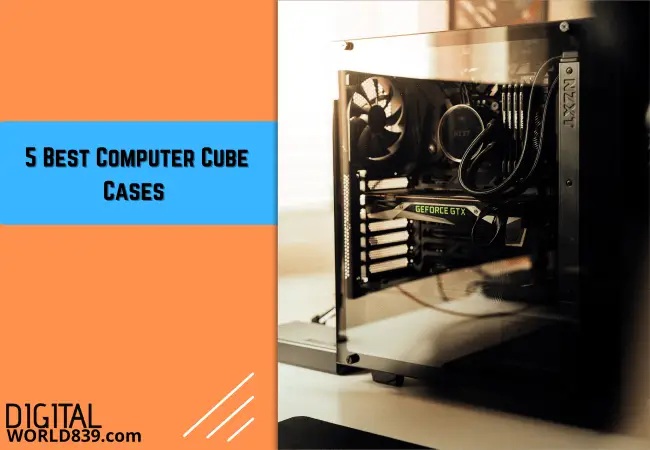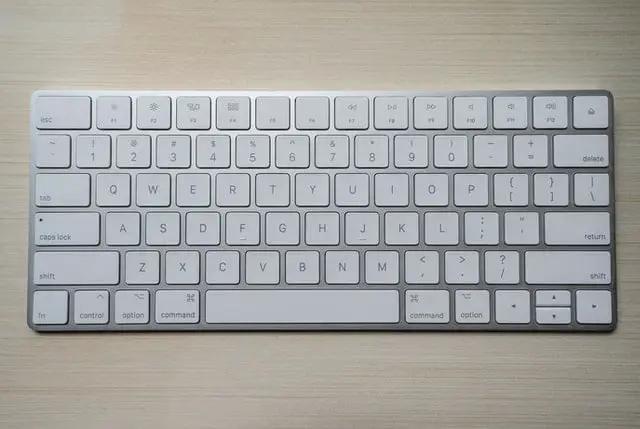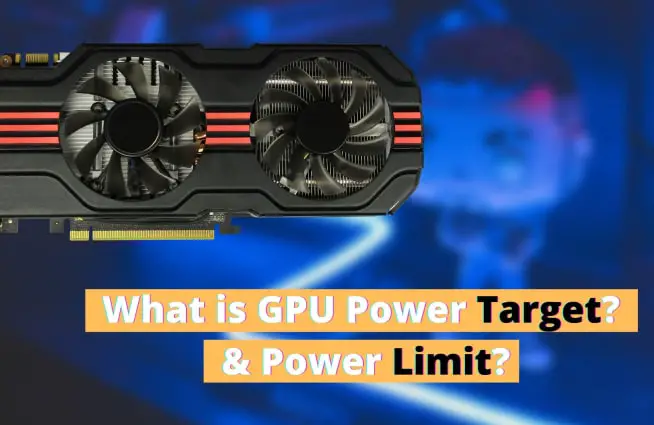If you are in the market for either an upgrade or a new PC or a laptop, you will be greeted with two choices for this – integrated vs dedicated graphics card.
Whether gaming, rendering videos, creating 3D models, or shuffling through everyday tasks such as web browsing and checking your emails – having the right video card can make all the difference! So, what’s the difference between the two? Is one better than the other? And which one’s entirely more suitable for your specific use case?
In this post, I’ll dive deep into the pros, cons, differences, and best uses of each type of graphics card to help you make an informed decision. Read on to understand how integrated vs dedicated graphics cards stack against each other!
What Is Integrated Graphics Vs Dedicated Graphics?

Rendering images onto the screen is quite a resource-hungry and challenging task, especially in the case of gaming, 3D processing, and photo or video editing. Therefore, this arduous task is delegated to dedicated graphics cards such as NVIDIA GTX 1660, RTX 3080, or AMD Radeon RX-7900.
On the other hand, many CPUs have capability to handle graphical processing tasks. These CPUs have integrated graphics – GPUs built into the processor chip are also referred to as APU (accelerated processing unit). AMD and Intel might call them different titles, such as Vega Graphics or Integrated Graphics, respectively (but all these terms roughly mean the same thing).
These are built into most “standard” laptops and computers, mainly a good option for cost-effective laptops.
Currently, each processor from Intel (i.e. Core i3, i5, and i7) as well as AMD (i.e. Ryzen 3, 5, 7) has an integrated GPU, so it’s only a matter of the motherboard whether the CPU is supported.
If Integrated graphics will do the job of graphical processing, Why do you need a Dedicated graphics card at all?
While integrated graphics can handle graphical processing, its potential is still limited and less powerful than dedicated graphics – partly because you can not pack too much power in such a confined space as available to the integrated graphics processor.
The limited space also invites CPU overheating as there isn’t enough surface area for heat exchange.
Not to mention that these CPUs have to borrow resources from the rest of the system (yes, system RAM). While the dedicated graphics, on the other hand, have their own hardware and VRAM.
Therefore, instead of allocating multiple tasks to one component, the CPU – the result being not great performance – in contrast, dedicated graphics will handle a single task (graphical processing) and do it quite remarkably as well.
With that said, dedicated GPUs are naturally more powerful than integrated graphics, but are they the right choice for you? Not exactly.
Why Should You Stick With INTEGRATED Graphics?
There are plenty of scenarios when integrated graphics will do an excellent job for you. Here are a few that make integrated graphics a good choice for you:
i. You’re on a budget
Integrated graphics cards have the advantage of being cheaper, leading to less expensive computers and laptops.
While installing a mid-tier or even a budget-tier dedicated graphics card is not as simple as that. Most of the time, you would need an entire rig rebuild. You will also have to upgrade your PSU to keep up with the wattage requirement of the GPU.
And perhaps you have an older motherboard that works on DDR3 RAM. So, if you need DDR4 RAM, guess what? You’ll also need to upgrade your motherboard! With integrated graphics, you won’t have to deal with all that. They are a good value for money for plenty of tasks, including gaming.
ii. You’re an occasional gamer
The incredibly good news about some of the integrated graphics CPUs is that they can run most games. The performance of the graphics built into the CPU has been improving year by year. If you want to play a game “lightly” casually with “built-in CPU graphics,” depending on the game title and graphics settings, it is possible.
Although you would have to turn down the settings and play at a lower FPS, you won’t miss out on gaming just because you don’t own a dedicated GPU.
For instance, you can play many modern titles like DOTA 2, League of Legends, and CS: GO – an Intel HD 4000 can run CS: GO at 1080p at 40+ FPS, even without a GPU. Moreover, GTA 5 with 40+ fps on AMD’s vega, from Ryzen 5 5600G.

iii. You don’t perform graphics-intensive tasks.
If you use your PC mainly for surfing the internet, watching movies, completing worksheets, and writing documents, well, you don’t need a dedicated graphics card.
Today’s integrated graphics processors are powered enough to handle even video streaming at 4K.
Moreover, a laptop that relies solely on integrated graphics will be more power efficient for longer battery life.
However, if you feel your system’s getting slow and you should upgrade it, try installing an SSD instead HDD or increasing RAM to speed up the performance.
Limitations of INTEGRATED Graphics
The biggest drawback of integrated graphics is that they consume the system’s resources. And that, too, isn’t placed at a higher priority – meaning, the system’s processes would be given more resources, and the leftover resources would be allocated to the graphical processing.
Another way to look at it is, for example, if your computer has 8 GB of RAM with 2 GB for shared graphics memory, you will only left 6 GB for general computing tasks. With only this much RAM, you will feel your system slowing down. Additionally, integrated graphics suffer from thermal throttling. Since you are packing a lot of power in a confined space, they can heat up quickly and easily.
However, manufacturers are introducing ways to increase the graphics capabilities of integrated systems. Graphics capabilities increased as many users wanted high-definition videos, photo editing, and gameplay. However, the integrated system is still unsuitable for complex 2D gaming, 3D gaming, and video editing.
Pros & Cons of Integrated Graphics Card
| Pros | Cons |
| Affordable | Not Powerful to Process Graphical Tasks |
| 2 in 1 Chip | Use System Resources like RAM |
| Require Overall Lower Wattage | Can Thermal Throttle during Intensive load and Heat |
| Good for Light Gaming | – |
| Doesn’t Need Additional Space or Cooling like Case Fans | – |
Why Should You Get DEDICATED Graphics?
So far, it has been discussed that integrated graphics can’t be much powerful. However, if you need a better solution, you might want to get a dedicated graphics card.
And unlike integrated graphics, discrete GPUs have their own PCB, cooling solution, and RAM and, as a result, are more expansive in their power potential. Thus, it not only will give you more power but also reduce its workload on the main processor, both of which will help your computer run better.
For example, if your RTX 3080 has 12 GB of memory, it is entirely separate from your computer’s RAM and doesn’t have to use from the system’s memory.
Of course, just because a dedicated graphics card helps a computer run better doesn’t necessarily mean that all PC users should opt for a system with a dedicated GPU specifically. Here are some situations when you should get a dedicated graphics card:
i. You love gaming
If you love gaming (who doesn’t), you should get dedicated graphics. While integrated graphics will run a game, sadly, that’s only what it will do. But if you want a decent gaming experience, you will need dedicated graphics support.

The good news is that if you are on a budget, even an entry-level GPU or a mid-range card like the RX-580 or GTX 1650 will pump out a solid performance. This means you can enjoy modern titles such as Call of Duty: Warzone, Spider-Man: Miles Morales, Gotham Knights, and more; that too, quite comfortably at 1080p 60 FPS+.
ii. You are building a workstation
While you might have to think thoughtfully when choosing between integrated vs dedicated graphics for your laptop or desktop, however, for workstations, I’d recommend getting a dedicated graphics card.
This not only gives you better choices for an upgrade down the line but also ensures that you always have a capacity for resource-hungry tasks. Who knows, your situation might change even half a year later, and you find yourself gaming or performing high-level photo- or video-editing.

Dedicated graphics cards are purposely designed for hardcore gamers and creative editors alike (some GPUs are better for gaming, while others are for editing). Adobe Photoshop, Premier Prom, AutoCAD, Solidworks, and Ansys, are some professional software that can benefit significantly from dedicated graphics cards.
The main drawbacks of dedicated graphics cards are that they are expensive, bulky, consume a electricity a lot, and generate a lot of heat. These characteristics make it difficult to put a dedicated graphics card in a laptop.
Apart from these limitations, the dedicated card is much more powerful than the integrated graphics. A reliable video card is perfect for those who want the best visual experience, whether gaming or graphics. The visual design of the game continues to improve. You need to plan ahead and find a card that will last you for at least a few years before you need to upgrade GPU.
Pros & Cons of Dedicated Graphics Card
| Pros | Cons |
| Able to Deliver Superior Performance in both Gaming and Professional Applications | Require Relatively More Budget |
| Doesn’t use System’s Memory, It has own PCB, RAM which is much Faster | It take up much more space inside the PC case |
| It can be Upgraded without having to Change the Processor | Use More Power form PSU or Laptop’s Battery |
| Recommended for Gamers & Graphic Designers | Require Equally Powerful Components & cooling solutions for GPU temp to Prevent Bottlenecks |
| Lifespan is usually Longer | – |
How You Can Choose The Right Graphics For Yourself?
Now that you know all the significant differences between integrated graphics and dedicated GPUs, it’s time to choose one for you. Here are the questions you need to ask yourself to pick the right one according to your use case:
What programs and applications are you planning on using?
Integrated graphics is suitable for finishing worksheets, web surfing, and watching movies.
What’s your budget?
A mid-tier discreet GPU does not cost much; don’t forget to consider the upgrades associated with a GPU upgrade – such as RAM, motherboard, a modular or non modular power supply, etc.
Are graphics important to you?
For gamers, the answer’s almost always a resounding “yes.” If your priority is gaming, a GPU is highly recommended.
Do you need to consider power consumption?
While desktop PCs can conserve power during idling to prevent electricity wastage. Laptop users need to consider battery life as discreet graphics consume more battery life on laptops.
FAQs
Which is best for a laptop – integrated or dedicated graphics?
While laptops are designed with portability in mind, there isn’t much space for stronger but bulky components. Integrated graphics fit inside the CPU chip, saving plenty of room. Additionally, integrated graphics don’t consume as much power, which is why most laptops come with integrated graphics.
Can you install an integrated graphics CPU on all motherboards?
No, not all motherboards have video output ports, meaning you won’t have a slot to plug the HDMI cable from your monitor into the motherboard. In this case, you must pair the motherboard with a dedicated graphics card with a video output port.
How much performance boost can you expect from discreet GPU over integrated graphics?
In Dec 2022, around 1.97% and 1.65% of users played games on AMD Radeon Graphics and Intel Iris Xe, respectively, as reported by Steam. Intel Iris Xe can provide performance similar to a GTX 560. AMD Ryzen 9, a high-end integrated graphics processor, falls short by almost 3 times than RTX 3090. Although, 3090 costs much more too.
Can I stream 4K videos on integrated graphics?
The answer to this depends on the specs of your integrated graphics as well as the overall system. For example, you will need sufficient RAM to ensure the video doesn’t face stutters. However, Intel Iris Xe will stream 4K videos for you, considering the specs of the rest of the system.
- Related: 10 Best Things To Do After Building A PC That Shouldn’t Miss.
- Read Also: CPU Vs GPU Vs RAM – Which Is More Important For Gaming?
Summing It Up
Dedicated graphics can deliver higher performance than integrated graphics. However, there are several scenarios when integrated graphics are better for you. To summarize everything:
- Processor with an integrated graphics card: Users who are occasional gamers who don’t mind lowering the resolution (720p) and its filters (low or medium quality), basic tasks: office automation, web browsing, watching videos or retouching at an amateur level photo retouching. They also do well on laptops and space-constrained systems.
- Dedicated graphics card: Users who want to play smoothly, with good resolution and maximum graphics on their computer. It also boosts video rendering or applications that make the most of your graphics card, without forgetting those users who always want to be up-to-date and upgrade down the line.
This ends the article on the integrated vs dedicated graphics card. You can leave a comment if you have any, questions, suggestions or something to add.




